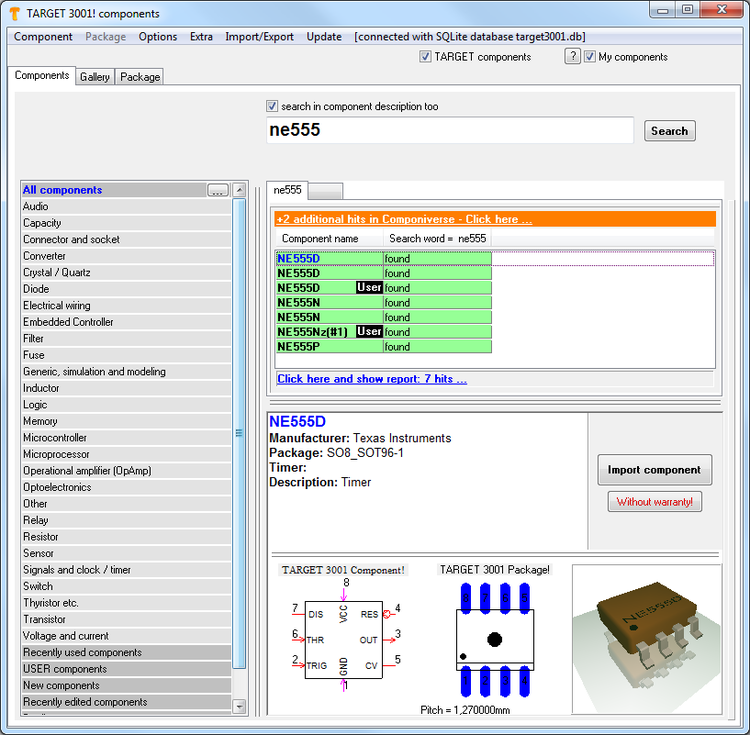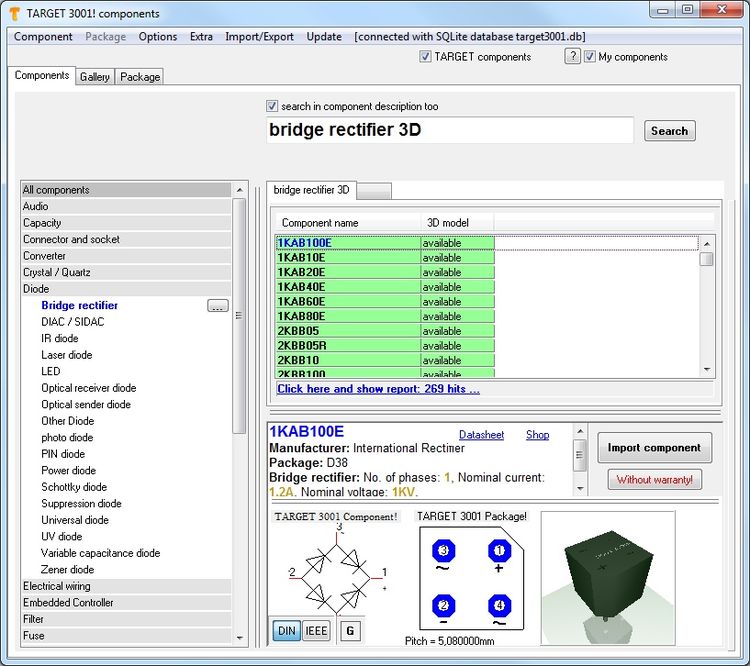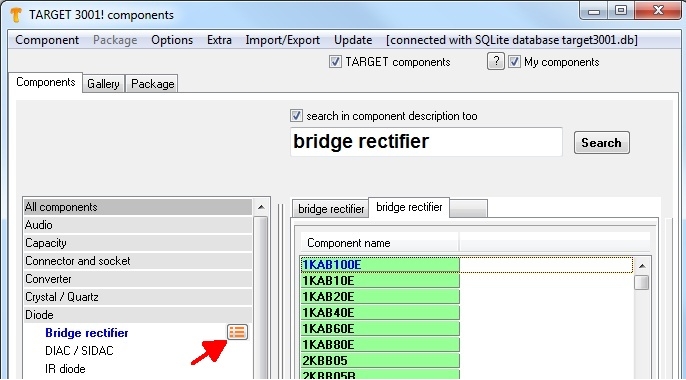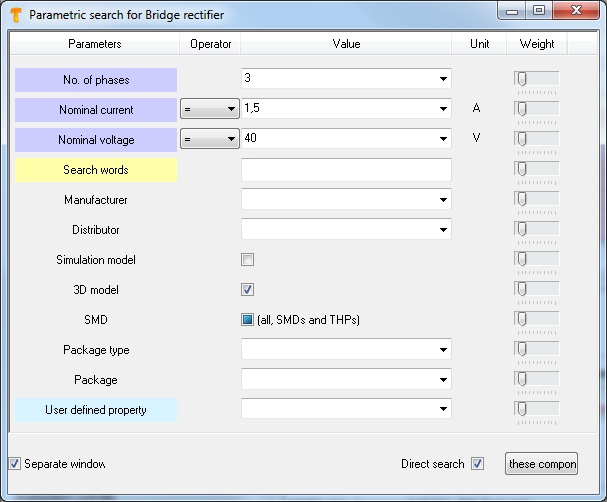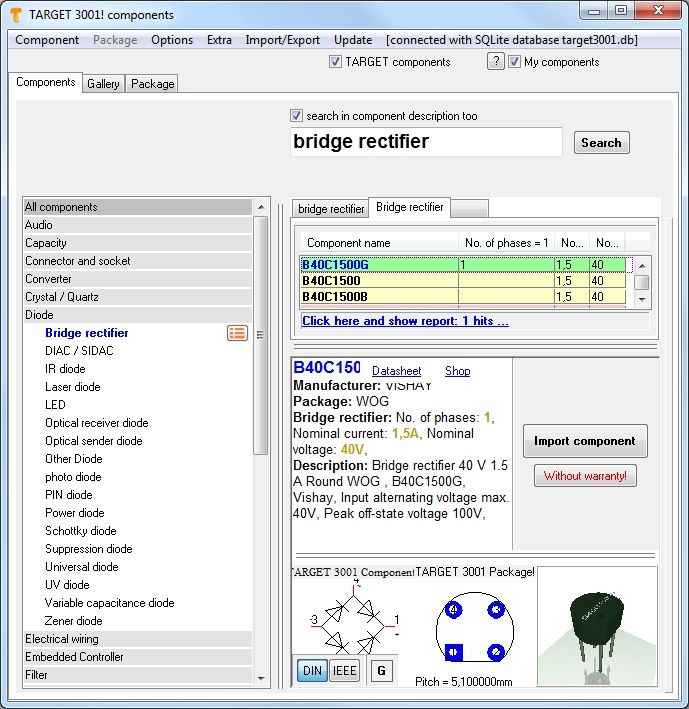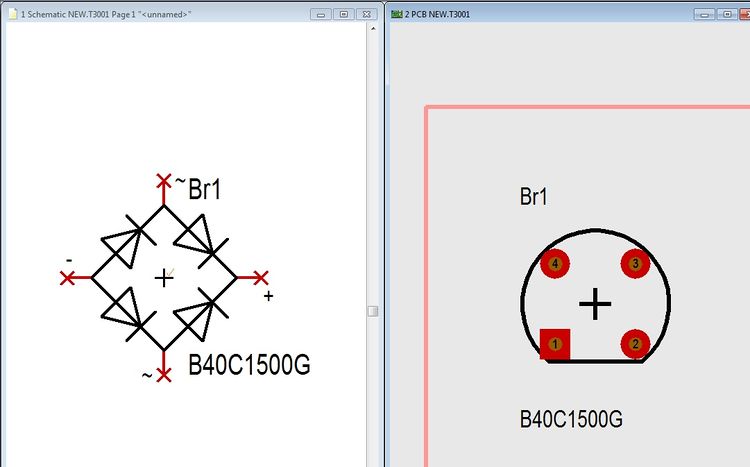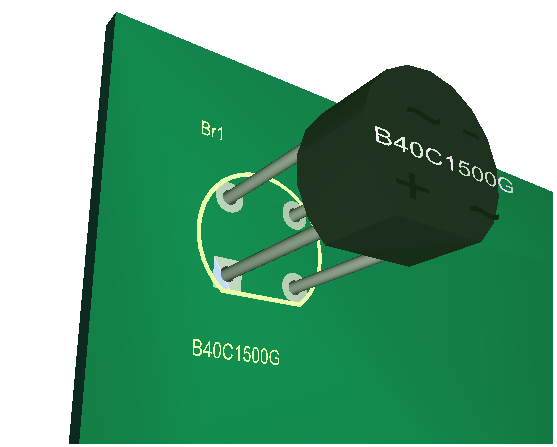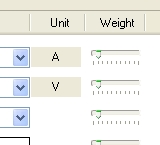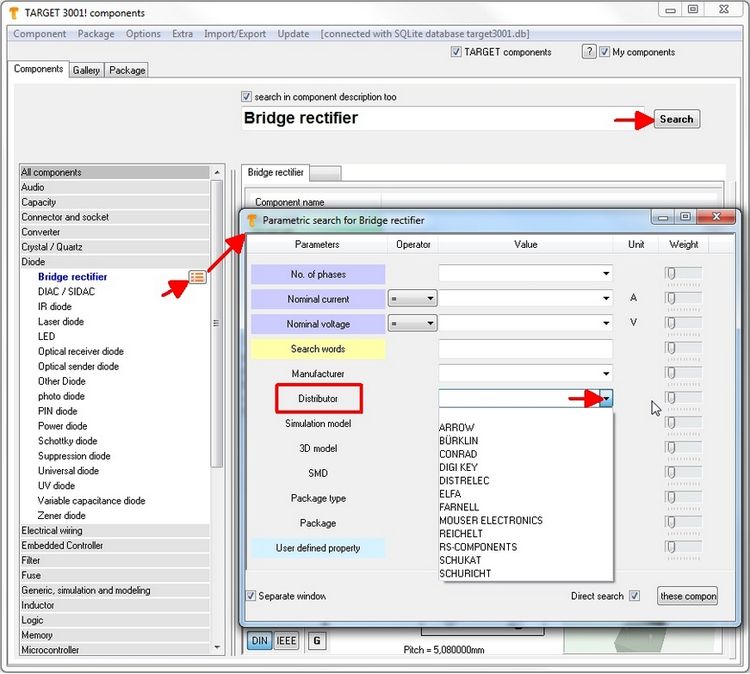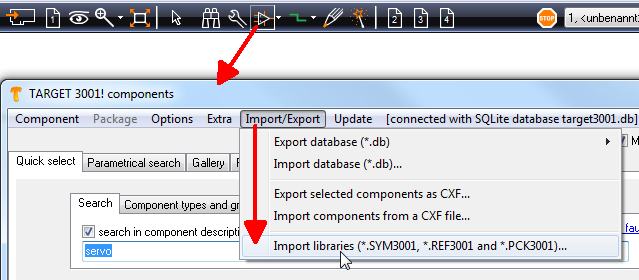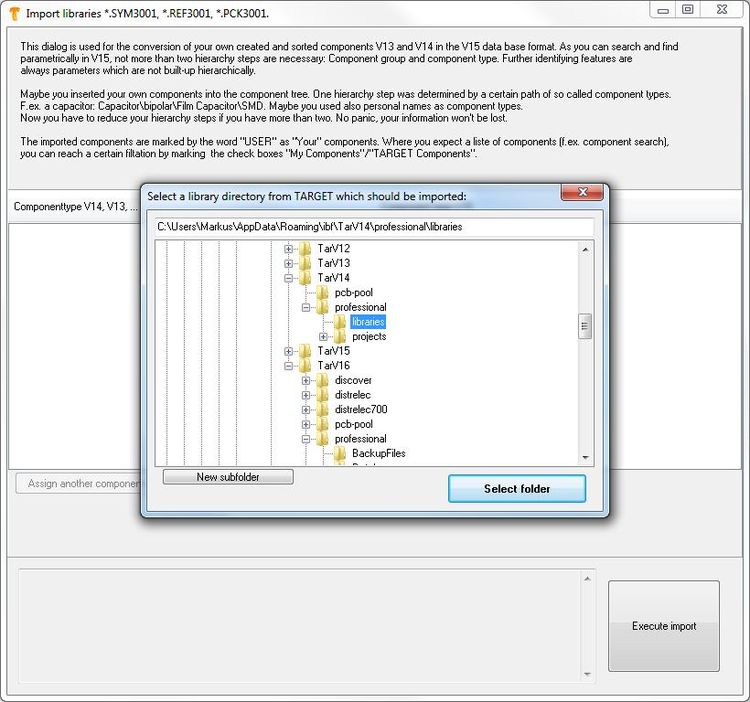Component database
General
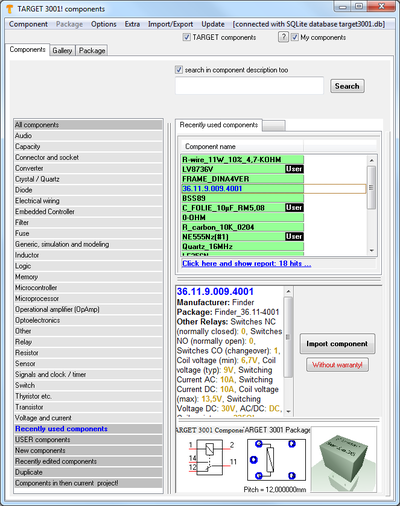
Say "Good Bye" to the library idea. There are no component libraries any more.
Instead there is only one data base containing all components and all related elements.
Each component can be identified by its name and/or parameters. This SQL database is named target3001.db. The component data base runs locally on every PC independently from the web.
This is the location of the data base on your PC.
The data base is server compatible that means you can install the data base to a server so that different clients have access to it at the same time. The terms of the TARGET 3001! license policy please see the article License. Open the component database by the icons ![]() or
or ![]() or use the keyboard key [Ins]. For the edition of an existing component please press functional key [F2]. The component databasse offers various search options: the tab Components, the Tab Gallery and the tab Packages. It is possible to browse within the amount of parts delivered by TARGET 3001!, in your own customized USER-parts (self drawn or self assembled) or within both. Tick the boxes accordingly.
Some items of the data base menus are self explanatory. Others are explained in the article Component browser.
or use the keyboard key [Ins]. For the edition of an existing component please press functional key [F2]. The component databasse offers various search options: the tab Components, the Tab Gallery and the tab Packages. It is possible to browse within the amount of parts delivered by TARGET 3001!, in your own customized USER-parts (self drawn or self assembled) or within both. Tick the boxes accordingly.
Some items of the data base menus are self explanatory. Others are explained in the article Component browser.
Where is the component data base located on my computer?
The component database is one single file named: target3001.db.
After you have installed TARGET 3001! please have a look here to find it:
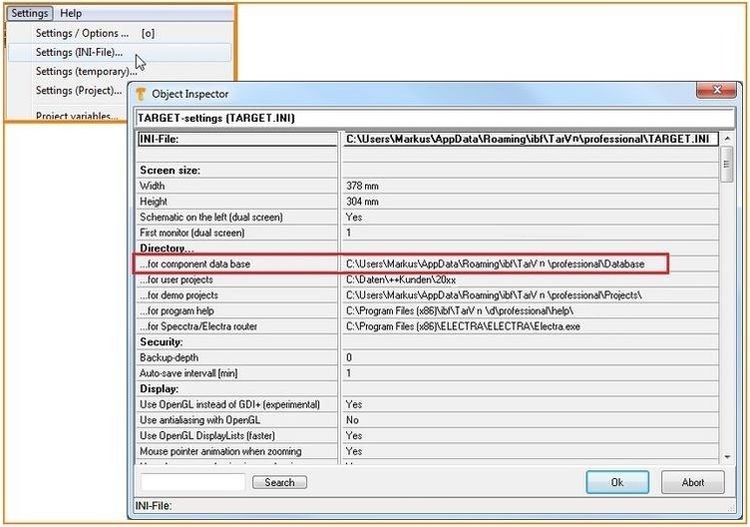
Image: How to find the location of your component data base. "Markus" that is me as a user. Your user sure will be different.
Using Windows Vista und Windows 7/8/10 you will find it here:
C:\Users\[username]\AppData\Roaming\ibf\TarVn\[edition]\Database
Using Windows XP you will find the SQLite component data base here:
C:\Documents and Settings\[username]\Application data\ibf\TarVn\[edition]\Database
Exchange [username] by your individual user name or by All Users (using WinXP) or Public. Exchange [edition] by the name of your edition, e.g.. professional or discover. The n in TarVn means your current main version number, e.g. 30
If some folders in your Windows explorer are hidden, please set your Windows the way that you can see all folders and all file extensions. You can place the component data base file to any folder you like, you only need to point TARGET there. Please see TARGET menu "Settings/Settings(INI file)". Also network drives with UNC names can be created, e.g. \\server\target3001\database. If several users want to use the data base simultaneously it is recommended to use a MySQL-Server .
"In my version V30 the data base path points to V19!" No problem at all. Do a free data base update to get all current parts. So you are up to date while all USER parts remain untouched.
You can also use a directory in DropBox, OneDrive or Google Drive to keep the SQLite database synchronised everywhere.
Alias: where is the data base? Directory of the data base folder of the data base data base folder path to the data base
How to find a part?
First open the component browser e. g. using key [Ins] or by the schematic icon "Insert component":

Image:Open the componet browser by the icon: "import component"
There are four general situations to find a component:
1. You know the name of the component e. g. NE555 or 2N3055 or a part of the name. In this case you will enter to the Search line.
2. You know the component type and maybe a value of the parameter e. g. resistor 10k. In this case you will search by parameters.
3. You know how the component looks like. In this case you may be guided by the Gallery.
4. You look for a certain component package (housing, soldering pattern). Search and import it to the canvas in order to edit it and to save it under a different name.
If you still can't find the part, you might consider to draw it in TARGET 3001! yourself.
Component seach
"I need a NE555 - what to do?"
Press on your keyboard key [Ins] in order to open the component data base. Initially you are in Tab "Search". Enter the name of the component or parts of it to the search line. After pressing the "Search" button the result might look like this:
You see there are genuine TARGET parts found as well as USER parts which either might be modified copies of TARGET parts or self drawn parts by the user. Now select from the list of results (green) your favorite part and import its symbol to your schematic by "Import component" in order to wire it. The package with 3d model is assigned to it and is memorized in the list of packge proposals. If later the work in the layout starts one gets the package proposals in to the layout. All pads are connected by air wires (= ratsnest) according to the wiring in the schematic.
The tab "Quick select" now is tab "Components"
Search for key words while all is allowed: Compomemt name, value, designation, description, value, manufacturer, types etc. and combinations from it. Upper and lower case in writing is not crucial for the search. If you tick the box ![]() above the search line, it is not only searched within the component names but also in the component descriptions.
above the search line, it is not only searched within the component names but also in the component descriptions.
A tick at ![]() focuses the search to genuine TARGET-Parts (including todays update).
focuses the search to genuine TARGET-Parts (including todays update).
A tick at ![]() focuses the search to USER parts. Combining both is possible.
focuses the search to USER parts. Combining both is possible.
Using the keys Page up and Page down resp. Arrow up, Arrow down selects searching in Components (= symbol and package) or only in packages (light blue field). Using the catch word "Bridge rectifier 3d" makes TARGET 3001! search in the range of all component names including the descriptions. At the same time TARGET 3001! recognizes that the appendix 3d refers to the existence of a 3D model with the package. Therefore in the row of search results the category 3D will be opened. All components non interpreted are going to be used within the field Catchword=Bridgerectifier.
The green column shows the results. Colors different to green are possible.
The colouring means:
- green = matches
- yellow = no fault but missing data
- white = no parameters available
- red = mismatch regarding parameters
The more keywords you use, the more columns you get.
The display shows schematic symbol, Landpattern (package, footprint) and 3D View. A click on the 3D view flips the image and allows a modified view.
For example if you search for "ST" or "Maxim", TARGET 3001! automatically recognizes the entries as manufacturer. Using the button Import to the right of the screen you get the symbol into your schematic and bring the package proposal to the list for later use in the layout.
The black highlighted word User means that this is a part which has been manipulated or modified by the user , e.g. a self edited component or one which had been brought to a separate component group...
I have got a question here...
The parametric search
If you search for a certain component kind you will find it highlighted in the list to the left. The list shows component groups (darker gray) and component types (lighter gray). Additionally you will see a little button allowing a search for parameters related to the part in question. The left part of the dialog shows all components subsumed in groups (grey highlighted). Important: There are only these two levels: groups and types.
As soon as you have clicked the button mentioned (red arrow), a window opens showing a structure of parameters so that values can be entered specificly to the components character.
This is the list of results:
The button "Import component" gets the part to the schematic and prepares the backage for insertion to the layout:
In the 3D view you would have something like that:
Weighting, sorting
Searching the TARGET 3001! component database is a kind of content focused selection process as it is known from Google®. One can take influence on the range within the list of matches by shifting the slider for each parameter.
The following weighting is given by default:
1. Catchwords in name/description (100)
2. Manufacturer (50)
3. Package (25)
4. rest SMT,... (5)
I have got a question here...
How do I search for parts available in a distributor's shop?
You need to open the parametrical search. First select the component type you like to search. In this example: "Bridge rectifier":
Set the parameter "Distributor" to the name of your preferred distributor (drop down list). Additionally - if you want - tick the box "3D Model", so that you will get only those parts listed having a 3D model. The more parameters you set, the smaller the selection gets.
I have got a question here...
How to search by the use of the Gallery
You have a part in your hand but no clue what it is? Compare it to similar parts. Please have a look here: Gallery
Component not found?
If you still haven't found what you're looking for, you can take a look at COMPONIVERSE® which is an online exchange of TARGET user parts on the web. If there is nothing to be found either, please have a look at Ultra Librarian or at Samacsys to download the part. If you still haven't found it, please draw a component yourself. Always begin with the drawing of the package then draw the symbol. How to proceed please also see here: Edit component
I have got a question here...
Edit component types
Add new parameters to a component type
Network situations with the TARGET 3001! database
The structure of the TARGET 3001! database
Single user situation with local SQLite component data base
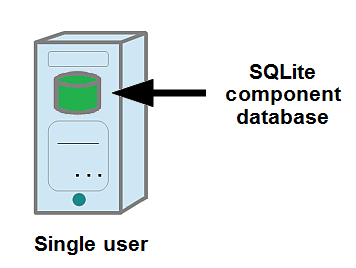
Image 1: Single user situation with local SQLite component data base
- for low and medium sized data traffic
- no server needed while database is embedded locally
- no additional installations needed
- components can be assigned according to parameters, they can be assigned to groups and types
- individually preferred parts can be assigned to lists
- consistency within the data (no -groups, -types, -names double)
- lists can be placed to tabs in the browser
- reach your preferred parts with few clicks
- parametric search (every component type keeps an individual set of parameters to be set for search)
- semantic search (keyword "led red" e.g. leads you to red LEDs. Keyword "4k75W" e.g. leads to the resistors)
- Creation of new or modified components within the data base as derivates of existing parts (independently from schematic and layout)
Two-user situation with two local SQLite component databases

Image 2: Two-user situation with local SQLite component databases
If only Chris creates components working with a SQLite setup can continue. A CRON-Job could copy the data base file from Chris to Robin after each change. Then no MySQL server would be necessary.
Network with access to one central MySQL client-server data base
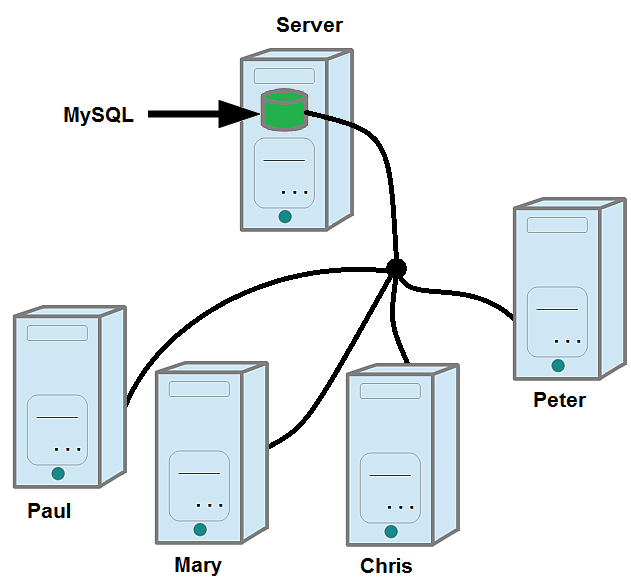
Image 3: Network with access to one central MySQL client-server data base
- the expert solution for the administration of huge amounts of data
- MySQL-power in a Client-Server-Network
- all colleagues use the same common database and not hundreds of separate libraries
- open and well proven data base technology
Client-Server-Network giving access to one central data base
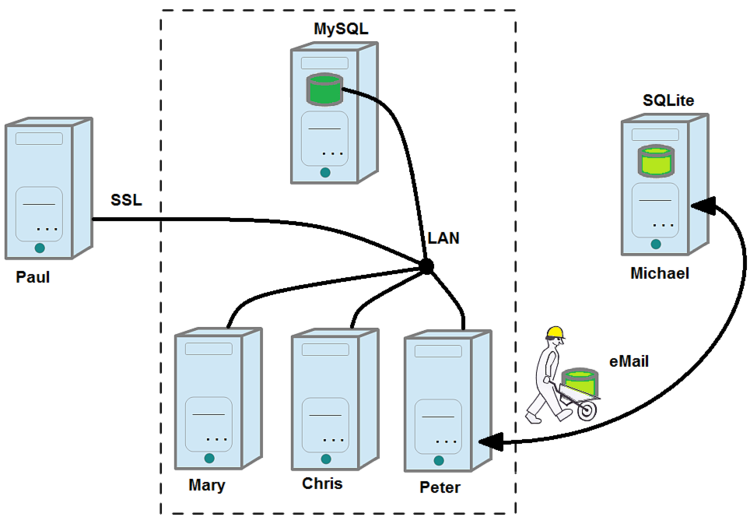
Image 4: Client-Server-Network giving access to one central data base. There is oportunity to install a mirror of the MySQL database on an external computer (Michael) to run it SQLite and bring it back.
- direct use of the transfered data base
- data import into an existing data base (Michael or Peter)
Update the component database
Convert older libraries to the data base
In the data base dialog select menu "Extras/Import libraries SYM3001, REF3001 and PCK3001". A browser opens from which you can choose your source libs. Confirm the selection with OK and then press button "Import components" (bottom right).
Now TARGET 3001! checks whether your existing component types (rem: a component type in V14 and older is represented by it's path in the tree view) matches with the data base. As a result you get your old parts listed in colored line to the left.
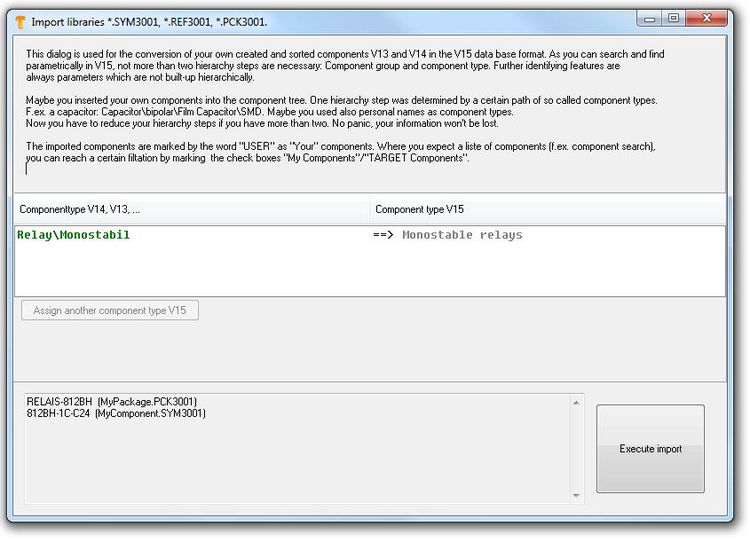
In the left column you will see "your" component types according to your structure. The colors mean:
Green: Component group and type already exist in the database - files can be overtaken directly.
Blue: Component group and -type matches with the data base structure but needs to be generated this individual way by TARGET 3001! (automatically done).
Red: Component group and -type (s) are unknown to the database. The user must do the assignment manually.
At any time you can do an assignment to a component type by M2 upon the line in question.
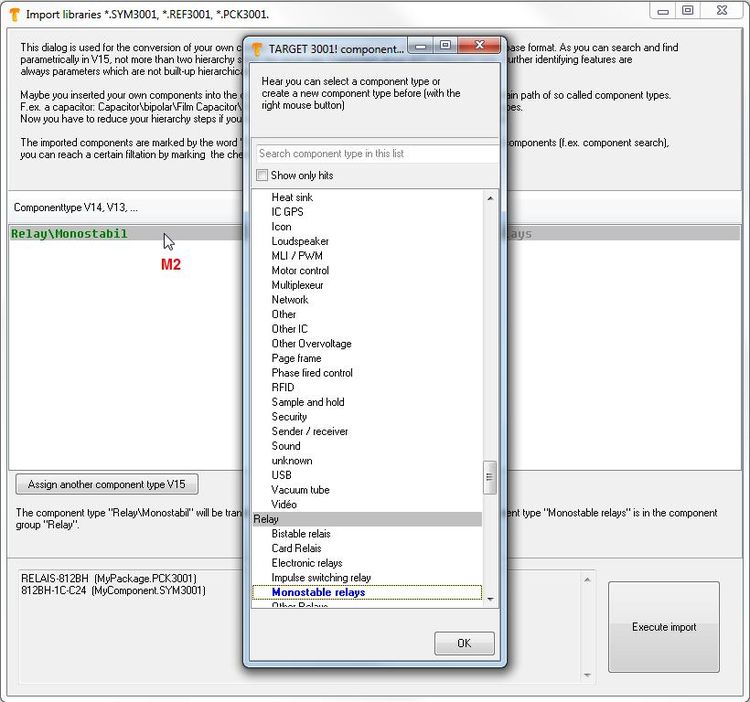
Or you may use the button "Assign a different component type V15". You then select an appropriate component type or you create a new one by M2.
Also a new component group can be created by M2 upon the gray background of any component group. See main window of component browser left hand side:

If a user has duplicated a certain part for his own purposes, so there is a hash (#) and a perpetual number fixed to it in the sense of "which copy number is this?" At the same time the flag "User" is fixed to it. That means that the user has manipulated this component. Thus it is taken to the amount of "own" components. It will remain untouched by automated component updates.
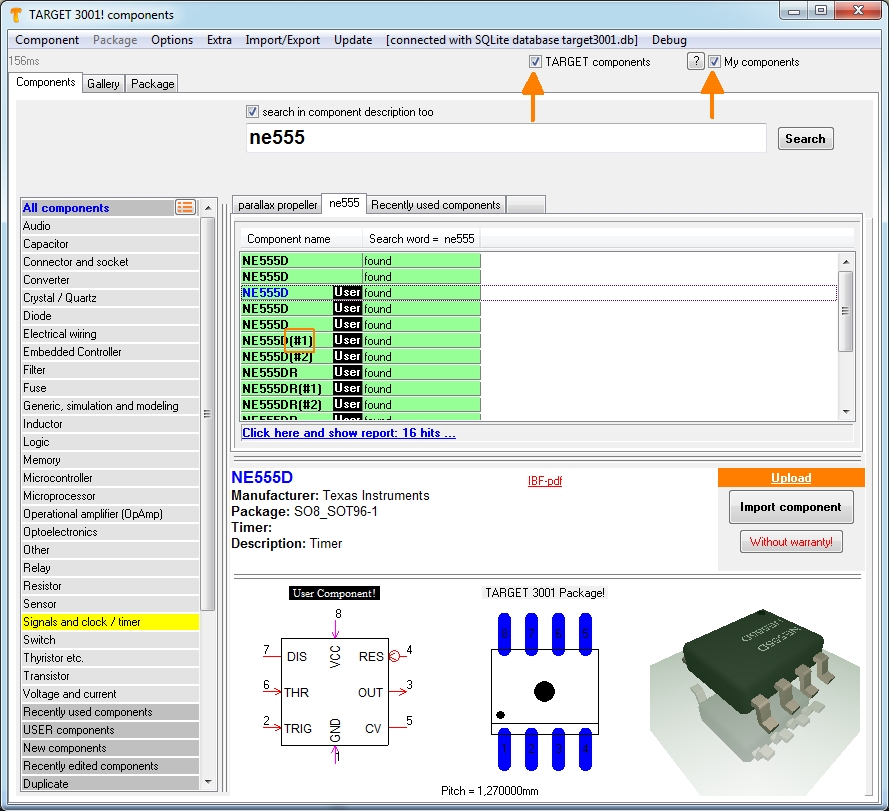
In the TAB "My components prior to V15" you see the sub-groups "Libraries" and "Component tree view" each with the display you know from those days....
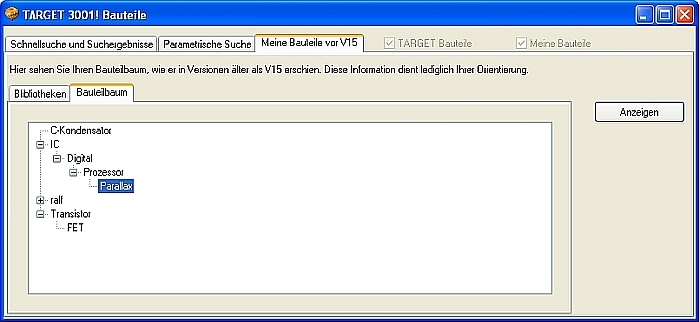
Image: taken from Version 15...
I have got a question here...
Lists for components and packages
In the database there is no copy of the same part with identical name and manufacturer. Nevertheless a certain component can be part of one or more individual lists created by the user. For example the list: "My preferred operational amps" or the list: "Parts for TV, Phono" or "Peter's parts" oder "The parts of the stepmotor project" or ...
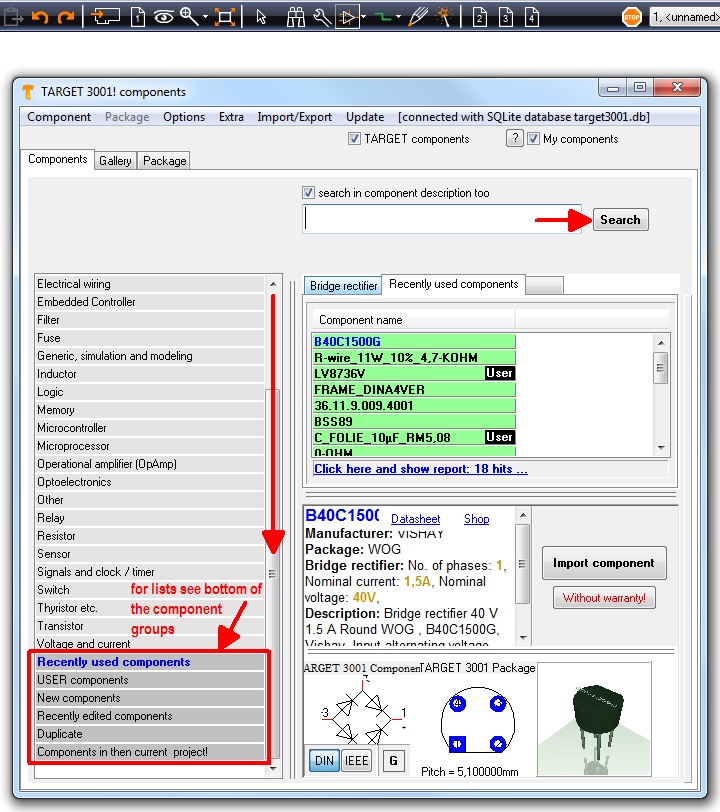
Thinking in lists is similar to thinking in libraries which means to show a selection of parts according to certain creteria. Assign a part to a list by klicking M2 at the part in the main view of the component browser. Now follow the dialogs of the option bottom of list:
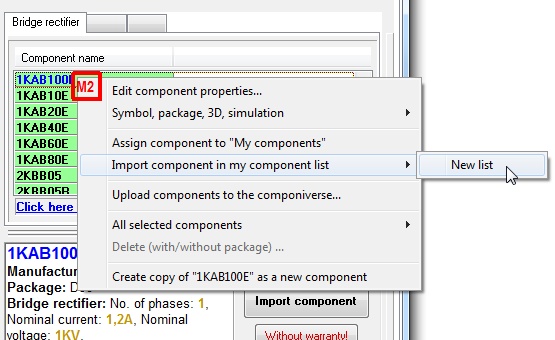
Right mouseclick on the line of a part allows assigning it to a list
In order to edit lists, please see menu Extra / EditSymbol/Package lists:
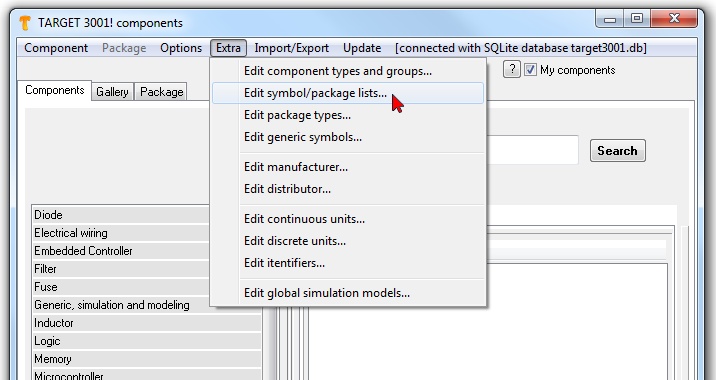
Data base backup when upgrading
During the installation of TARGET 3001! a destination directory is proposed:
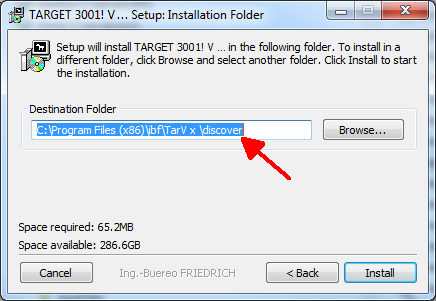
Proposed directory
and the component data base will be copied to a sub directory.
C:\Programs\ibf\TarVx\discover\AppData\Database\
If TARGET 3001! gets started the first time the data base will be transfered to "C:\Documents and settings\<your user>\ApplicationData\ibf\TarVx\discover\Database\" The directory may vary according to the Operation System. TARGET now uses the data base from the "ApplicationData" - directory.
So there will be used different data base directories for the versions.
If a user grades up from a smart to an economy, he needs to copy his smart database to the Economy directory or point the database path in Menu Settings/Settings (INI-File)..." to the smart data base directory.
TARGET 3001! at this time does not check during the installation process whether a version already exists in order to use its database.
I have got a question here...
Update V16 --> V17 --> V18. What about the database?
During a V18 installation by default a new data base gets installed. If you had a V15, V16 or a V17 with a database which keeps your USER parts sure you like to use them in V18 as well.
During the installation of your new main version you get asked whether to overtake an earlier database. Select and decide from the dialog.
Alternatively set the database path in V18 to your existing database from V15, V16 or V17. You also might copy your old data base to the directory where your new Version of TARGET expects it to be. DON'T USE the Import/Export function in the component browser. This is meant only for individual parts.
Import components from external sources directly into the TARGET component database
"I am a component manufacturer and would like to import my components directly into the TARGET component data base. Every TARGET user should have immediate access to the CAD data of my components including data sheet link and link to my shop."
For this you need a MySQL access to the TARGET 3001! component database, please contact us:
I am a component manufacturer and would like to have mySQL access...
Your access data could look like this:
Server: office.ibfriedrich.com
User: <MyUsername>
Password: <MyPassword>
Here you have to enter these:

Image: You can only edit the components of the user whom you represent as the manufacturer. This means that the company Miller cannot change the components of the company Smith.


